Safely over the Øresund bridge

At Øresundsbron, safety is our top priority. This applies to customers as well as employees, and you are never alone when you are on the Øresund bridge. Traffic is monitored around clock by trained staff, both manually over cameras and automatically using meters and sensor along the entire connection.
Are you in need of emergency assistance?
Call us at
Traffic Center: +46 40 676 6770 or +45 3341 6770
Emergency assistance: 112
There is a defibrillator on both sides of the toll station and all our customer assistants are trained to operate them.
What do you do in case of a breakdown or accident?
On the bridge
Pull into the emergency lane on the right-hand side and switch on the hazard warning light
Put on your yellow safety vest
If you are in the emergency lane, move to safety about 50 metres in front of the car (do not go over the guardrail)
If you pass an emergency staircase, go to safety on the stair landing
Call the Øresund Bridge Traffic Centre on +46 40 676 6770 / +45 33 41 67 70 or the emergency services on 112
Follow the instructions and wait for help
In the tunnel
Pull over to the right side and switch on the hazard warning light
Put on your yellow safety vest
Provide first aid if necessary
Leave the car and walk to the nearest emergency phone or call the emergency centre on 112
When you pick up the emergency phone, you are in direct contact with the police. Stay by the phone.
In case of fire in the tunnel - evacuate via emergency door or emergency stairs
Help is on its way as soon as possible to transport you and your car to safety
Drive safely - follow the speed limits
It takes only 11 minutes to cross the bridge if you follow the speed limits. The Øresund bridge has variable speed displays depending on the conditions. There are speed cameras on the entire connection. It is important to keep an eye on the speed limits to get there safely and avoid fines. The maximum speeds are:

On the bridge and Peberholmen
On the bridge and Peberholmen the speed limit is 110 km/h, just like on an ordinary motorway.

In the tunnel
In the tunnel the speed limit is 90 km/h for safety reasons, as there is no emergency lane.

Through the toll station
The speed limit in the toll station is 30 km/h in order for the censors to read license plates and tickets, and to ensure the safety of our staff working in the lanes. If you drive faster than this, it might take longer to pass as it makes it harder for the system to read your license plate.
Emergency phones and emergency exits
The tunnel is equipped with emergency telephones that put you in direct contact with emergency personnel. The Øresund bridge Traffic center can listen in to assess whether or not it might be necessary to divert traffic. The emergency phones are located 88 meters apart, on the right-hand side of the tunnel.
There are emergency exits to be used in case of fire or a major accident. The doors lead to a safe area.
If you experience problems on the bridge, such as engine failure or a flat tire, please contact the Øresund bridge Traffic center.

Useful information:
Water leaks
Small water leaks may occur in the tunnel. This is completely natural due to the structure of the tunnel and completely harmless.
Defibrillator
There is a defibrillator on both sides of the toll station and all our customer assistants are trained to operate them.
Always open
The Øresund bridge is basically always open. On rare occasions we may be forced to close the bridge for traffic, e.g. severe weather conditions or special incidents. This primarily happens during the winter months. Stay update by visiting our Traffic information.
Speed bumps in the toll station
Note that there are speed bumps in the road in the toll station towards Denmark. If you drive too fast through the toll stations, the dynamic speed bumps are activated. The implementation of these dynamic speed bumps has reduced the number of speeding cars by up to 95%. These speed bumps are only present in the toll station towards Denmark, and the Swedish side has Swedish border control.
Double dashed lines in the tunnel
The road in the tunnel has double dashed lines for when we need to create bi-directional traffic when necessary. This typically happens during maintenance work in the tunnel.